NFTs exploded into the world in 2021, generating great wealth for the lucky some, and it then experienced a significant downward shift. Their history, brief as it is, is a complex one which reflects both propensities of such emerging technologies of potential vs unviability.
Design & Build has interviewed Valeriu Costin, the founder of SnwoMan, to gain a stronger understanding of the world of NFTs. “Without offering investment advice, since I am not a financial adviser: As a means of tokenizing real-world assets, NFTs seem to offer a lower entry point for investments, with a possibility of higher returns; than their more traditional counterparts” Mr Costin tells us.
It was thus at the very beginning of this interview that Valeriu Costin clarified that he is neither advising people to invest in NFTs nor is he obfuscating the fact that, as in all other forms of investments, there is a certainty of risk. This is quite typical for disruptive technologies, which tend to pose high risk and high reward – upon new entrants. The risk of the innovation not being successful and the natural pushback derived from people’s reluctance to adopt change are but two of the reasons behind wasted resources and financial losses when adopting them.
And yet, about 3 months ago, Blackrock Ceo Larry Fink said on Bloomberg Television “We believe the next step going forward will be the tokenization of financial assets”. He also said that with tokenization “we would have instantaneous settlement”, “if you had a tokenization everything would be immediate”, and “we believe this is a technological transformation for financial assets”. These statements from the CEO of the world’s largest asset management firm with $10 trillion currently in its portfolio must surely prompt us into further understanding fungible tokens (FTs; also known simply as “tokens”) and non-fungible tokens (NFTs) and their significance to our organisations and their investments needs and ambitions.
“We believe the next step going forward will be the tokenization of financial assets”
In 1996, Kodak had infamously recognised the opportunities and threats analogue photography was to experience through the advent of digital photography and hence invested over $2billion in R&D for digital imaging; an operation which had dismally failed as their hasty installing of 10,000 digital kiosks in their partner stores proved to be inferior to HP, Canon and Sony’s launching home-based products instead. The reaction, in theory, was sound. The strategy however was not. This is quite typical for disruptive technologies, which tend to pose high risk – and high reward – upon new entrants. The risk of the innovation not being successful and the natural pushback derived from people’s reluctance to adopt change are but two of the reasons behind wasted resources and financial losses when adopting them.

WHAT ARE NFTS?
Going by Merriam-Webster, “A non-fungible token (NFT) is a a unique digital identifier that cannot be copied, substituted, or subdivided, that is recorded in a blockchain, and that is used to certify authenticity and ownership (as of a specific digital asset and specific rights relating to it). Avalanche (one of the world’s largest blockchain entities) also tells us that NFTs work by tokenizing digital, and also physical assets: “This process involves converting an asset into a digital token, which can then be transferred, sold, or stored on a blockchain.”
THE INTERVIEW
“Without offering investment advice, since I am not a financial adviser, as a means of tokenizing real-world assets NFTs seem to offer a lower entry point for investments, with a possibility of higher returns; than their more traditional counterparts.” It was thus at the very beginning of this interview that Valeriu Costin clarified that he is neither advising people to invest in NFTs nor is he obfuscating the fact that, as in all other forms of investments, there is a certainty of risk.
While NFTs were mostly useful to monetise digital art, they are today also evolving into a means of fractionalising ownership of real world assets: this is the gist which we garnered from Valeriu Costin. He continued to explain that the attention given to NFTs is growing exponentially. “This is a huge step forward for the industry, and having major players involved does strongly suggest to me that we are heading into the right direction.”
“By tokenizing real-world assets, ownership can be divided into smaller, more liquid units, enabling fractional ownership and potentially increasing accessibility to investment opportunities”
Tokenization of real-world assets involves representing ownership of physical assets, such as real estate, art, or commodities, as digital tokens on a blockchain. Mr Costin explained “These tokens are cryptographic representations which provide proof of ownership and which can be traded or transferred electronically. And by tokenizing real- world assets, ownership can be divided into smaller, more liquid units, enabling fractional ownership and potentially increasing accessibility to investment opportunities. Additionally, tokenization offers benefits such as increased transparency, efficiency, and accessibility to global markets.”
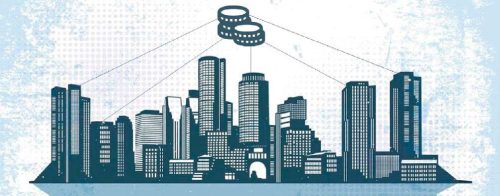
Does this mean that a developer may now acquire the capital to develop a large project to the entire world; by fractionalising its ownership via tokens; rather than by pursuing largescale traditional investments which tend to be nation-centric? “Yes, indeed!” he simply answered. Mr Costin then offered us another example: “the technology exists right now that allows a multitude of people to buy portions of one sole apartment.” Mr Costin clarified that “the correct legal elements must be in place to support these techological opportunities. And needless to say, professional legal advice on such matters is always a must.”
Mr Costin is a founder of SnwoMan; a web3 project. Mr Costin explained that he has gathered a community of a group of pioneers using the SnowMan Portal; a user-friendly blockchain-integrated web3 platform built by SnwoMan to tokenize and manage real-world communities. This community is called the SnwoMan YClub.
“transitioning from building and managing real-world assets to tokenizing them is a logical evolution to me”
“The SnwoMan Portal acts as an interface which utilises NFT technology to tokenize and manage real-world assets. SnwoMan NFTs are the core digital assets created by SnwoMan to exemplify the potential of NFTs”, he continued telling us. “SnwoMan has two main goals: that of introducing real-world communities into the web3 by tokenizing and managing their digital presence; and of expanding the world-wide presence of SnwoMan by offering to sell SnwoMan NFTs to a wider audience.
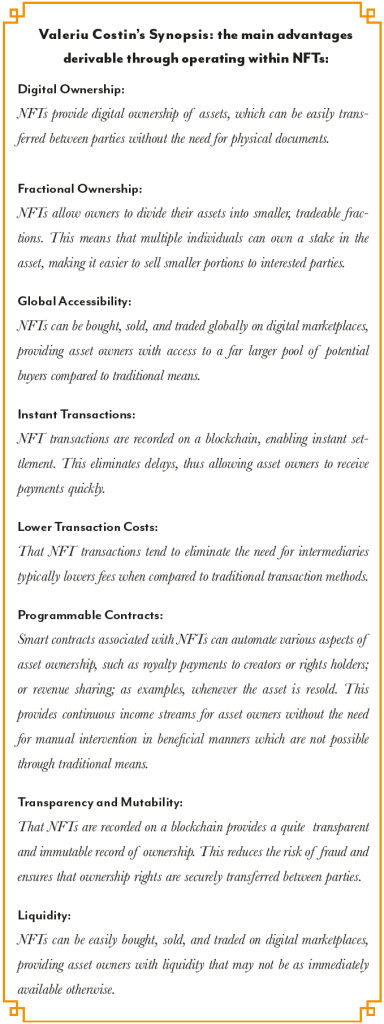
“SnwoMan represents the collective identity and spirit of the community, embodying its core values of creativity, collaboration, and empowerment. As a symbol of unity and innovation, SnwoMan serves as a guiding force for members as they navigate the evolving landscape of Web3.” Valeriu Costin explained that he branched off into NFTs from turnkey contracting, rental management and running a woodworking workshop; businesses which are still going strong. We asked him what inspired him to enter the NFT space, and what opportunities he has seen for growth and innovation within this industry.
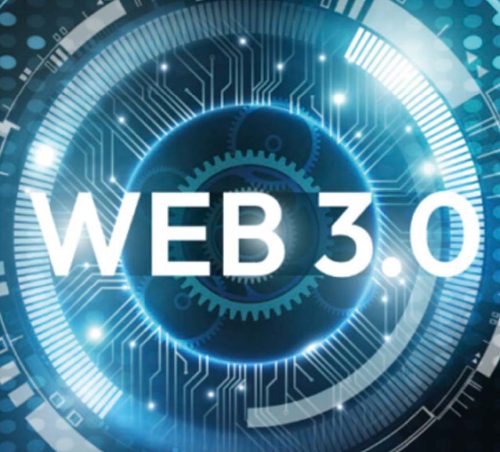
“Mr Costin is of the undivided opinion that governments should leverage this asset and not hinder its implementation”
“While it may not appear as a big deal at first glance, transitioning from building and managing real-world assets to tokenizing them is a logical evolution to me.” Stemming from a background in computer science and engineering, Mr Costin leveraged turnkey contracting as a stepping stone, seizing the opportunity that arose amidst the social and financial turmoil of 2020 due to the COVID-19 pandemic, he explained. “The Growth potential is immense, it needs a lot of energy and bright minds to grow and flourish. And I personally find this industry to be in sync with the property business.”

acquisition and as secure certificates of authenticity.
Though NFTs commenced their life being regarded as digital artwork, since the ‘first wave’ has passed, we are seeing a wider range of different uses for NFTs being presented to the markets: membership cards, vouchers, gift cards, concert tickets, gaming skins, collectibles, luxury goods, real estate ownership, digital and physical works of art, and fan tokens are suitable examples to this, Mr Costin told us.
He added that “By offering consumers direct access to the digital assets (via tokens), the asset owners can eliminate all the excess fees and friction of the intermediaries. It’s a much more direct interaction.”
Though NFTs commenced their life being regarded as digital artwork, since the ‘first wave’ has passed, we are seeing a wider range of different uses for NFTs being presented to the markets: membership cards, vouchers, gift cards, concert tickets, gaming skins, collectibles, luxury goods, real estate ownership, digital and physical works of art, and fan tokens are suitable examples to this, Mr Costin told us. He added that “By offering consumers direct access to the digital assets (via tokens), the asset owners can eliminate all the excess fees and friction of the intermediaries. It’s a much more direct interaction.”
IMPORTANCE OF NFTS IN THE COMING YEARS
Mr Costin explains that when transactions are based on blockchains such as ‘XRPLedger’ (XRPL), they are highly environmentally friendly as “this consumes very low carbon emissions. In fact, SnwoMan is based on this very XRPLedger, which also is secure and resistant to attacks and tampering” he added.

world’s first apartment was sold in 2021 as an NFT
Mr Costin continued to explain that “NFTs have already made significant waves in various industries, from art and collectibles to gaming, real estate, and beyond. Their ability to represent unique digital or real-world assets, establish ownership rights, enable fractional ownership, and facilitate transparent and secure transactions has positioned them as a potential standard in the digital economy. “The evolution of NFTs in the coming years is likely to be dynamic and multifaceted, driven by technological advancements, shifts in consumer behaviour, regulatory changes, and emerging use cases. Overall, the future of NFTs holds immense potential for transformative impact across various industries, empowering creators, collectors, and consumers to participate in a decentralised and inclusive digital economy.

“As technology evolves and adoption grows, the landscape of NFTs is bound to continue to evolve, presenting new opportunities and challenges for innovation, creativity, and value creation” he said.
Mr Costin is of the opinion that we are currently at the bottom of the first wave: people are still somewhat skeptical of the technology, much as they were with the advent of emails; and that indeed, while many people may not fully understand the underlying technology of email protocols, they nonetheless use email interfaces daily for communication without hesitation. “Similarly, blockchain technology has the potential to become seamlessly integrated into our daily lives, powering a wide range of applications and services without users needing to understand the intricacies of cryptographic algorithms or consensus mechanisms.
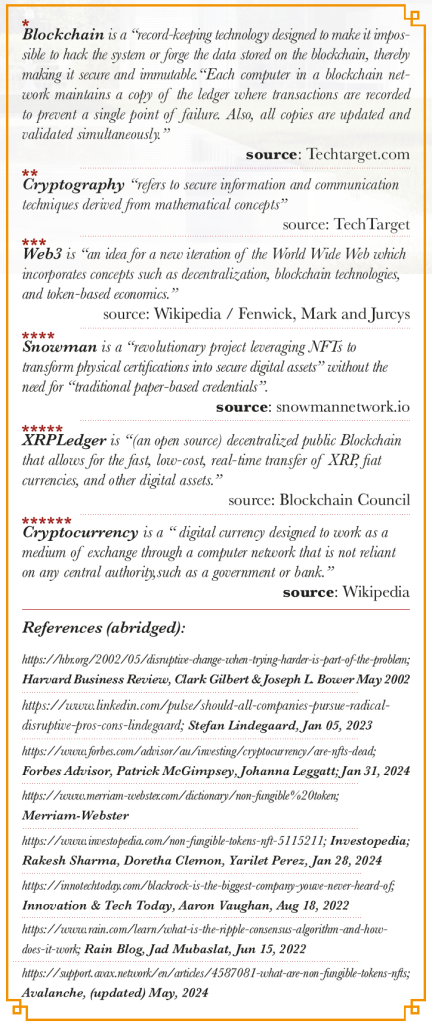
“Blockchain technology, with its decentralized and immutable ledger system, has the potential to revolutionise various industries beyond just cryptocurrencies. NFTs represent one such application, offering a novel way to represent ownership, authenticity, and provenance of digital and real-world assets. As more user-friendly interfaces, scalable solutions, and regulatory frameworks are developed, blockchain-based technologies, including NFTs, are poised to become increasingly accessible, practical, and impactful. They could streamline processes, enhance transparency, reduce friction, and unlock new opportunities for value creation across diverse sectors of the economy.
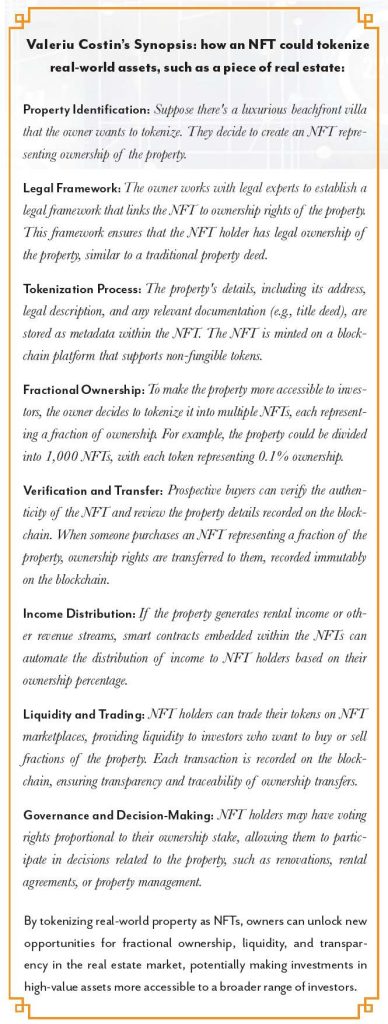
“blockchain technology has the potential to become seamlessly integrated into our daily lives”
“While challenges and skepticism may persist in the short term, the underlying momentum of innovation and the growing recognition of blockchain’s transformative potential suggest that we are at the cusp of a significant shift in how we interact with technology and value exchange. As with any disruptive technology, perseverance, education, and collaboration will be key to realising the full promise of blockchain and NFTs in shaping the future.”
What advice would you give to individuals or businesses looking to get involved in the NFT market, either as creators or investors? we asked. “DYOR : Do Your Own Research . The technology is here to stay, either you start early, or…”, he replied with a smile. “As we’ve seen with other disruptive technologies, volatility is characteristic to emerging technologies. So everyone should consider their own risk-reward appetite. History has also proven time after time that great opportunities arise from such events and hence I find it logical that companies, entities and individuals should duly consider to – or consider to duly embark upon – NFTs as part of their arsenal of investment tools.
SNWOMAN
We asked Valeriu Costin where he reckons the future of NFTs is heading, and what role he aspires that SnwoMan will play in shaping that future. He responded by telling us “We are one of the few entities in Malta that are talking about the tokenization of real-world assets (tRWA). And to this effect, we are building our SnwoMan YClub community around the SnwoMan; working solidly to foster awareness to the opportunities which exist thanks to this advanced technology. “I have no doubt that sooner or later everyone will be utilising NFTs, as we are using today cars, computers, credit/debit cards, vending machines, digital photography, emails, and so forth. “Here at SnwoMan, we have been in the scene from the beginning, and we suggest that everyone joins our community, thus giving us – and themselves – collective strength, to be at the forefront of gaining opportunities. Furthermore, we are glad to assist opportunity seekers in tokenising their own real-world assets.”
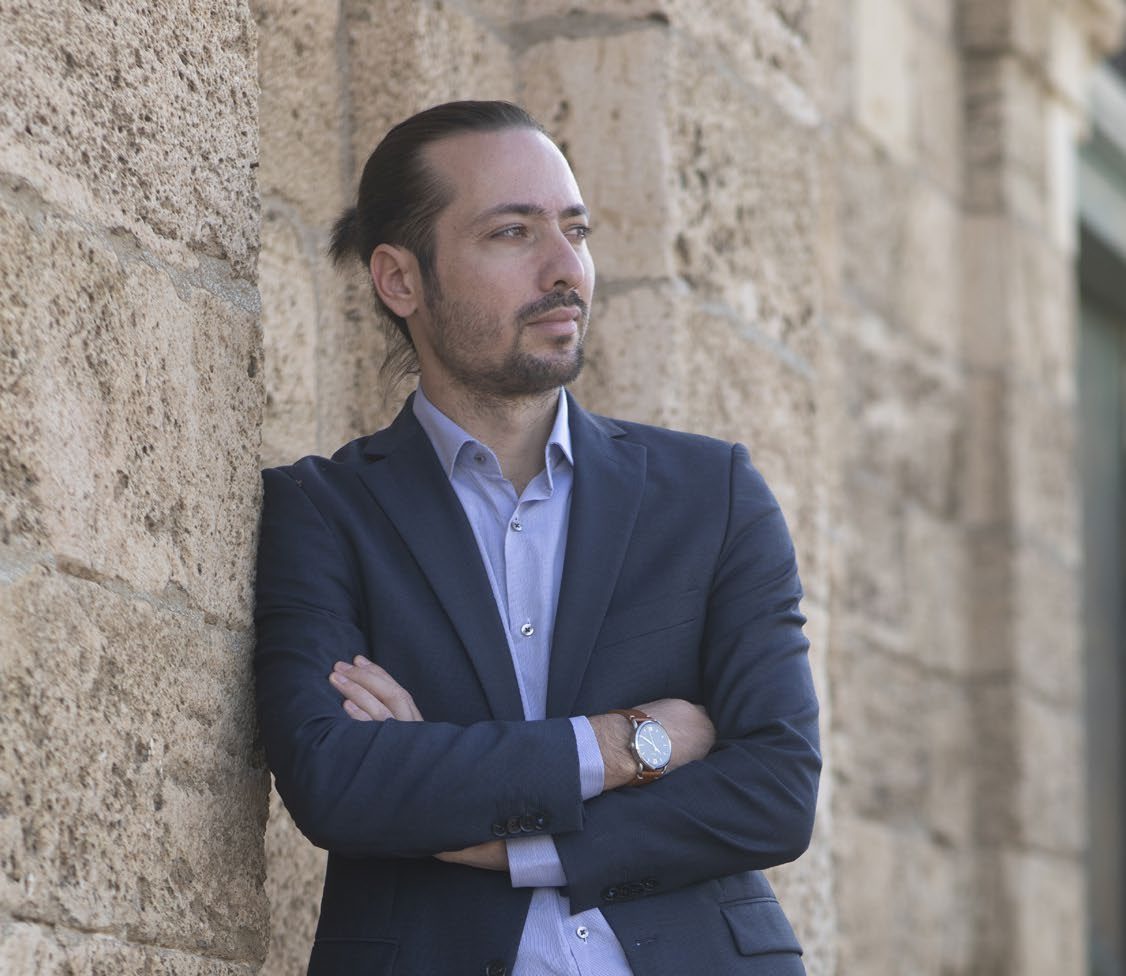
Comment